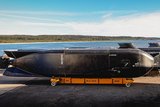BAE Systems details RAN design work
BAE Systems has released details on the work it will carry out to refine its Type 26 Global Combat Ship (GCS) design for the Royal Australian Navy (RAN). The company announced that it has signed a contract with the Australian government for the work under the RAN’s SEA 5000 Future Frigate programme on 1 September.
BAE Systems is one of three companies that will refine their designs for the programme, along with Navantia and Fincantieri.
The company said it will use the latest in modern digital planning capability to refine and tailor its designs to the Australian government’s requirements. To assist this process, BAE Systems will use a 3D visualisation suite to help improve understanding of the unique features of the ship design. This will enable greater understanding about design modifications the RAN requires and will help demonstrate how the Global Combat Ship could accommodate the required CEA Technologies’ phased-array radar system.
Glynn Phillips, BAE Systems Australia chief executive, said: ‘We look forward to demonstrating the adaptability and maturity of the Global Combat Ship design to meet Australia’s requirements for an anti-submarine warship frigate.
‘The Global Combat Ship design is the most modern, adaptable and flexible of all possible options available today, and I am confident that we will be able to demonstrate that it is the best able to meet the requirements of the RAN.’
The work is being carried out by BAE Systems, Fincantieri and Navantia as part of the Australian Department of Defence’s Competitive Evaluation Process for the programme.
More from Naval Warfare
-
![How the Anduril-HHI autonomous ship plan fits in with the US Navy’s MASC programme]()
How the Anduril-HHI autonomous ship plan fits in with the US Navy’s MASC programme
The new modular vessel is expected to be developed for both commercial and defence use, with a heavy focus on production speed and mission flexibility.
-
![Indo Pacific 2025: Autonomous systems reigned but can the Australian Defence Force afford it?]()
Indo Pacific 2025: Autonomous systems reigned but can the Australian Defence Force afford it?
Multiple autonomous systems and technologies were on display at this year’s Indo Pacific, but questions remain over how the Australian Department of Defence will balance the books.
-
![How the UK Royal Navy is powering up its hybrid fleet to combat new threats]()
How the UK Royal Navy is powering up its hybrid fleet to combat new threats
Since it announced its move towards a new “hybrid navy” earlier this year, the force has announced a number of new uncrewed technologies in the works.
-
![US and UK to begin Trident II D5 Increment 8 in October 2026]()
US and UK to begin Trident II D5 Increment 8 in October 2026
Trident II D5 Increment 8 will involve improvements to the shipboard navigation subsystem for the US Ohio and Columbia and the UK Dreadnought and Vanguard submarine classes.






















